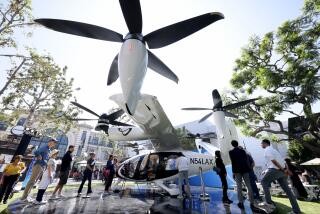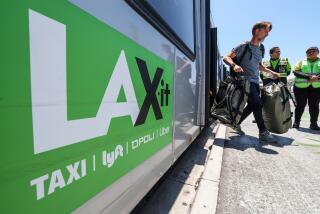LARRY E. SLAGLE, President, Yellow Cab of North Orange County
Taxicabs are to New York what freeways are to Southern California. So what place does a cab have in Orange County, where there are few places to hail a taxi? Yellow Cab of North Orange County, founded in Anaheim in 1945, has blossomed into one of the county’s largest operators with more than 100 vehicles. Larry Slagle, the president of the family-owned operation, now leads the International Taxicab Assn., a major industry trade group. He talked to correspondent Ted Johnson about taxi service here and nationwide.
How have you survived in Orange County, where most people have their own car?
Orange County is not a taxicab town. It’s not a public transit town. But it’s changing, little by little. We have survived mainly because of the tourist convention market that has developed here in Anaheim. When we first started it was very seasonal, primarily in the summertime. Then as the Anaheim Convention Center and Disneyland have grown, as well as the surrounding tourist attractions, it has allowed us to operate at a reasonable base 12 months out of the year.
Do you rely at all on local riders?
In terms of local ridership, we draw primarily the transit-dependent people who use buses, Dial-A-Ride and social services transportation. When those services shut down or when they get out and need to go across boundary lines, they utilize taxicab transportation. This is primarily the ridership base that is the backbone of the taxicab industry. In addition, one of the ways we have adapted, especially as the Orange County Transit District has developed its program of public transit, is to bid on and operate the Dial-a-Ride system.
Last year was a tough year in the taxicab business. Was it because the tourism and convention business was down?
Exactly. Tourism is probably 35% to 40% of our business. That is very significant, and it’s probably one of the highest in the nation. (Last year) tourism was down substantially. Businesses did not spend in the same manner at conventions as in other years. Disneyland, Knott’s Berry Farm and some of the other attractions had local discounts, so they kept their attendance numbers up. But the people who generally came to those type of attractions didn’t stay overnight, and they didn’t (use) public transportation. . . . So we adjusted the size of our fleet. We tried things like guaranteed rates between here and the airport.
Do you see an upturn?
We’re hoping that the war between the airlines will encourage some additional travel. People can take that saving and spend money on their vacations or at conventions. We’re also looking at the ride-share regulations with the (South Coast) Air Quality Management District. We think that is going to help us. We’re participating with many of those companies on something called the ‘guaranteed ride home.’ If (employees) come in on a car pool or a van pool and something happens at home--an emergency, a child gets sick--we provide transportation for that person home.
How will the proposed monorail system affect your business?
We believe we would perhaps lose some long trips, but we would pick some short trips. These people would be arriving (at a monorail station) without their own transportation. For example, if they put a monorail from Disneyland to John Wayne Airport, that would probably cut our long-trip business. But if that many people arrived here without transportation, then we would probably be busier with those short trips, to and from the hotels, Disneyland, Knott’s and other attractions. Basically, we think it is going to be an even trade-off.
What can be done to prevent robberies and other crimes against drivers?
Taxicabs, by the very nature of their mobility and isolation, are more vulnerable than we would like to see. We educate the drivers to keep their trip sheet out of sight, to not talk about how well they have done that day and to employ some better defensive characteristics. In terms of a shield or something like that, we don’t have one. We haven’t had the problems that they have had in some other communities. We have an emergency button on our automatic dispatch system that tells us if our driver is in trouble. The international association is working with the federal transit administration to develop a more effective shield that will incorporate some additional safety features, as well as the ability to communicate between the front and the back seat. But there is no good answer except for an armored-car situation where you separate the passenger compartment. Even then, if there is no communication with the driver, that affects the perceived level of service.
In 1986, you were the first operator in the country to install an automated dispatch system. What is the next major change?
(That dispatch system) eliminated a lot of the problems with voice and confusion with numbers. It allows us to pick the closest call, not just who gets on the radio faster. We think that was a major step in cutting down our response time in half. The thing we are looking at now is the automatic vehicle locater. We’ve just purchased a system that will allow us to find out where the cars are. It is primarily a safety feature. If a car is broken down, if the driver is assaulted, or the vehicle is stolen, we can track that vehicle down to within a hundred feet.
Do taxicab drivers get a bad rap?
They do. A lot of people, especially those smaller operators--the local transportation providers who make those same trips day in and day out--tend to say their image is very favorable. It generally tends to be in big cities where you run into problems with attitude and uncaring drivers. It generally stems from the fact that there are not enough cabs. They can be a little choosy, they don’t have to be tolerant of the riders’ feelings. They think that they’re going to get another trip anyway whether or not the passenger gets out. If you can get (the drivers) out of that mentality, then I think we’re moving forward.
On regulating taxicab service on the city, rather than the county, level. . .
“If we were licensed countywide, Disneyland and Anaheim may get great service, but Yorba Linda wouldn’t. Now, we have to do our job in each one of the cities to make sure they are happy with the service.”
On the dominance of smaller companies. . .
“Most of those people have not been exposed to the right kind of business practices. It is an area we can help them with.”
On improving the image of taxi drivers nationwide. . .
“It’s more educating what service is all about than (saying), ‘Here are rules and regulations.’ ”
On drivers leasing cars and running their own business. . .
“More and more drivers have gone into business themselves. But personally, I prefer having employees. It allows us more control.”
More to Read
Sign up for Essential California
The most important California stories and recommendations in your inbox every morning.
You may occasionally receive promotional content from the Los Angeles Times.










